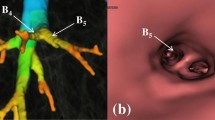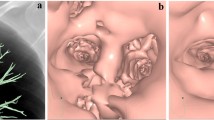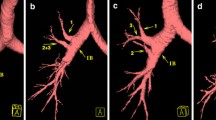Abstract
Purpose
The objectives of this study were to evaluate various branching patterns of segmental bronchi in the left superior and lingular lobes and to survey the anatomical diversity and sex-related differences of these branches in a large sample of the study population.
Materials and methods
Overall, 10,000 participants (5428 males, and 4572 females, mean age 50 ± 13.5 years [SD] years; age range: 3–91 years) who underwent multi-slice CT (MSCT) scans between September 2019 and December 2021 were retrospectively included. Using the syngo.via post-processing workstation, the data were applied to generate three-dimensional (3D) and virtual bronchoscopy (VB) simulations of a bronchial tree. The reconstructed images were then interpreted to identify and categorize distinct bronchial patterns in the left superior and lingular lobes. Cross-tabulation analysis and the Pearson Chi-square (χ2) test were used to calculate the constituent ratios of bronchial branch types and determine their significance between male and female groups.
Results
Our results revealed mainly four distinct types for the left superior lobe (LSL) bronchial tree, i.e., (B1 + 2, B3, 76.13%); (B1 + 2 + 3, 17.32%); (B1 + 3, B2, 5.74%); (B1a + B3, B1b + B2, 0.81%) and two types for the left lingular lobe (LLL) bronchial tree, i.e., (B4, B5, 91.05%); (B4, B5, B*, 8.95%). There were no significant sex-related differences in the proportion of bronchial branches in LLL (P > 0.05). However, sex-related differences were significant in the proportion of bronchial branches in LSL (P < 0.05).
Conclusion
The current study has validated the presence of segmental bronchial variations in the left superior and lingular lobes. These findings may have a crucial effect on the diagnosis of symptomatic patients, as well as in carrying out procedures such as lung resections, endotracheal intubation, and bronchoscopies.








Similar content being viewed by others
Data availability
The data that support the findings of this study are available on request from the corresponding author. The data are not publicly available due to privacy or ethical restrictions.
Abbreviations
- 3D:
-
Three dimensional
- 2D:
-
Two dimensional
- VB:
-
Virtual bronchoscopy
- LSL:
-
Left superior lobe
- LLL:
-
Left lingular lobe
- B1:
-
Apical segmental bronchus
- B2:
-
Posterior segmental bronchus
- B3:
-
Anterior segmental bronchus
- B4:
-
Superior lingular segmental bronchus
- B5:
-
Inferior lingular segmental bronchus
- B*:
-
Extra segmental bronchus
- B1 + 2:
-
Common stem of apical and posterior segmental bronchus
- B1 + 3:
-
Common stem of apical and anterior segmental bronchus
- B2 + 3:
-
Common stem of anterior and posterior segmental bronchus
References
Beder S, Küpeli E, Karnak D, Kayacan O (2008) Tracheobronchial variations in turkish population. Clin Anat 21:531–538. https://doi.org/10.1002/ca.20667
Boyden EA, Hartmann JF (1946) An analysis of variations in the bronchopulmonary segments of the left upper lobes of fifty lungs. Am J Anat 79:321–360. https://doi.org/10.1002/aja.1000790302
Boyden EA (1955) Segmental anatomy of the lungs a study of the patterns of the segmental bronchi and related pulmonary vessels. McGraw-Hill, New York. https://doi.org/10.1148/66.6.895b
Chassagnon G, Morel B, Carpentier E, Le Pointe HD, Sirinelli D (2016) Tracheobronchial branching abnormalities: lobe-based classification scheme. Radiographics 36:358–373. https://doi.org/10.1148/rg.2016150115
D’Antoni AV (2016) Gray’s anatomy, the anatomical basis of clinical practice, forty-first edition, by susan standring, editor-in-chief, elsevier limited. Clin Anat 29:264–265. https://doi.org/10.1002/ca.22677
Dalrymple NC, Prasad SR, Freckleton MW, Chintapalli KN (2005) Introduction to the language of three-dimensional imaging with multidetector CT. Radiographics 25:1409–1428. https://doi.org/10.1148/rg.255055044
Fetita CI, Prêteux F, Beigelman AC, Grenier P (2004) Pulmonary airways: 3-D reconstruction from multislice CT and clinical investigation. IEEE Trans Med Imaging 23:1353–1364. https://doi.org/10.1109/TMI.2004.826945
Gariani J, Martin SP, Botsikas D, Becker CD, Montet X (2018) Evaluating the effect of increased pitch, iterative reconstruction and dual source CT on dose reduction and image quality. Br J of Radiol 91(1088):20170443. https://doi.org/10.1259/bjr.20170443
Ghaye B, Szapiro D, Fanchamps JM, Dondelinger RF (2001) Congenital bronchial abnormalities revisited. Radiographics 21:105–119. https://doi.org/10.1148/radiographics.21.1.g01ja06105
Hammond E, Chan KS, Ames JC, Stoyles N, Sloan CM, Guo J, Newell JD, Hofman EA, Sieren JC (2018) Impact of advanced detector technology and iterative reconstruction on low-dose quantitative assessment of lung computed tomography density in a biological lung model. Med Phys 45:3657–3670. https://doi.org/10.1002/mp.13057
Horton KM, Horton MR, Fishman EK (2007) Advanced visualization of airways with 64-MDCT: 3D mapping and virtual bronchoscopy. Am J Roentgenol 189:1387–1396. https://doi.org/10.2214/AJR.07.2824
Huang M, Wang T, Wang X, Zhao X (2019) An anatomical study of the right bronchial tree using multi-detector computed tomography. Surg Radiol Anat 41:335–338. https://doi.org/10.1007/s00276-019-02199-7
Keenan RJ, Landreneau RJ, Maley RH, Singh D, Macherey R, Bartley S, Santucci T (2004) Segmental resection spares pulmonary function in patients with stage I lung cancer. Ann Thorac Surg 78:228–233. https://doi.org/10.1016/j.athoracsur.2004.01.024
Kiraly AP, Helferty JP, Hoffman EA, McLennan G, Higgins WE (2004) Three-dimensional path planning for virtual bronchoscopy. IEEE Trans Med Imaging 23:1365–1379. https://doi.org/10.1109/TMI.2004.829332
Krause GR, Lubert M (1951) The anatomy of the bronchopulmonary segments: clinical applications. Radiology 56:333–354. https://doi.org/10.1148/56.3.333
Lee KS, Bae WK, Lee BH, Kim IY, Choi EW, Lee BH (1991) Bronchovascular anatomy of the upper lobes: evaluation with thin-section CT. Radiology 181:765–772. https://doi.org/10.1148/radiology.181.3.1947094
Leroux BT (1962) The bronchial anatomy of the left upper lobe. J Thorac Cardiovasc Surg 44:216–224. https://doi.org/10.1016/s0022-5223(19)32975-7
Li Y, Xia L (2020) Coronavirus disease 2019 (COVID-19): role of chest CT in diagnosis and management. Am J of Roentgenol 214:1280–1286. https://doi.org/10.2214/AJR.20.22954
Ma X, Ma Y, Wang S (1997) Analysis of 270 cases of bronchial variation in lung segment. Chin J Pract Intern Med 10:593–596
Mehran RJ (2018) Fundamental and practical aspects of airway anatomy: from glottis to segmental bronchus. Thorac Cardiovasc Surg 28:117–125. https://doi.org/10.1016/j.thorsurg.2018.02.003
Mori K, Ema S, Kitasaka T, Mekada Y, Ide I, Murase H, Suenaga Y, Takabatake H, Mori M, Natori H (2005) Automated nomenclature of bronchial branches extracted from CT images and its application to biopsy path planning in virtual bronchoscopy. Lect Notes Comput Sci 3750:854–861. https://doi.org/10.1007/11566489_105
Naidich DP, Zinn WL, Ettenger NA, McCauley DI, Garay SM (1988) Basilar segmental bronchi: thin-section CT evaluation. Radiology 169:11–16. https://doi.org/10.1148/radiology.169.1.3420245
Perhomaa M, Lähde S, Rossi O, Suramo I (1997) Helical CT in evaluation of the bronchial tree. Acta Radiol 38:83–91. https://doi.org/10.3109/02841859709171247
Pitel M, Boyden EA (1953) Variations in the bronchovascular patterns of the left lower lobe of fifty lungs. J Thorac Surg 26:633–653. https://doi.org/10.1016/s0096-5588(20)30791-1
Reck M, Rabe KF (2017) Precision diagnosis and treatment for advanced non–small-cell lung cancer. N Engl J Med 377:849–861. https://doi.org/10.1056/nejmra1703413
Room C (1950) Nomenclature of broncho-pulmonary anatomy; an international nomenclature accepted by the Thoracic Society. Thorax 5:222–228. https://doi.org/10.1136/thx.5.3.222
Rosell J, Cabras P (2013) A three-stage method for the 3D reconstruction of the tracheobronchial tree from CT scans. Comput Med Imaging Graph 37:430–437. https://doi.org/10.1016/j.compmedimag.2013.07.003
Salvolini L, Bichi SE, Costarelli L, DeNicola M (2000) Clinical applications of 2D and 3D CT imaging of the airways—a review. Eur J Radiol 34:9–25. https://doi.org/10.1016/S0720-048X(00)00155-8
Scannell JG (1949) Bronchographic anatomy of the lungs. Surg Clin North Am 29:573–581
Sealy WC, Connally SR, Dalton ML (1993) Naming the bronchopulmonary segments and the development of pulmonary surgery. Ann Thorac Surg 55:184–188. https://doi.org/10.1016/0003-4975(93)90507-E
Ugalde P, Camargo J, de Deslauriers J (2007) Lobes, fissures, and bronchopulmonary segments. Thorac Surg 17:587–599. https://doi.org/10.1016/j.thorsurg.2006.12.008
Wahidi MM, Shojaee S, Lamb CR, Ost D, Maldonado F, Eapen G, Carof DA, Stevens MP, Ouellette DR, Lilly C, Gardner DD, Glisinski K, Pennington K, Alalawi R (2020) The use of bronchoscopy during the coronavirus disease 2019 pandemic: CHEST/ AABIP guideline and expert panel report. Chest 158:1268–1281. https://doi.org/10.1016/j.chest.2020.04.036
Wang T, Meng M, Huang M, Zhao X (2018) Variations of right bronchial tree: a study with multi-detector CT. Surg Radiol Anat 40:955–958. https://doi.org/10.1007/s00276-018-2033-1
Wu WB, Xu XF, Wen W, Xu J, Zhu Q, Chen L (2016) Thoracoscopic pulmonary sub-subsegmentectomy based on three-dimensional images. Ann Thorac Surg 102:389–391. https://doi.org/10.1016/j.athoracsur.2016.04.048
Yang Q, Xie B, Hu M, Sun X, Huang X, Guo M (2016) Thoracoscopic anatomic pulmonary segmentectomy: a 3-dimensional guided imaging system for lung operations. Interact Cardiovasc Thorac Surg 23:183–189. https://doi.org/10.1093/icvts/ivw085
Zhao X, Ju Y, Liu C, Li J, Huang M, Sun J, Wang T (2009) Bronchial anatomy of left lung: a study of multi-detector row CT. Surg Radiol Anat 31:85–91. https://doi.org/10.1007/s00276-008-0404-8
Acknowledgements
This study was supported by Major Scientific and Technological Innovation Projects in Shandong Province, China (2019JZZY020106, 2015ZDXX0201A02).
Author information
Authors and Affiliations
Contributions
SJ: project development, study concepts and design, literature research, clinical studies, data collection, data analysis, manuscript preparation, manuscript editing. YZ: project development, literature research, clinical studies, manuscript editing. DW: study concepts and design, clinical studies, data collection, data analysis. YM: study concepts and design, clinical studies, data collection, data analysis, statistical analysis. HL: study concepts and design, clinical studies, data collection, data analysis. CL: project development, study concepts and design, literature research, manuscript editing. SL: project development, study concepts and design, literature research, manuscript editing.
Corresponding author
Ethics declarations
Conflict of interest
The authors have no conflict of interest to declare.
Ethical approval
All procedures followed were as per the protocol of the work center and ethical standards of the responsible committee on human experimentation (institutional and national) and with the Helsinki Declaration of 1975, as revised in 2000. This work was approved by the Ethics Committee of the School of Basic Medicine of Shandong University (No. ECSBMSSDU2018-1-050).
Additional information
Publisher's Note
Springer Nature remains neutral with regard to jurisdictional claims in published maps and institutional affiliations.
Rights and permissions
Springer Nature or its licensor (e.g. a society or other partner) holds exclusive rights to this article under a publishing agreement with the author(s) or other rightsholder(s); author self-archiving of the accepted manuscript version of this article is solely governed by the terms of such publishing agreement and applicable law.
About this article
Cite this article
Javed, S., Mei, Y., Zhang, Y. et al. Identification of anatomical types of segmental bronchi in left superior and lingular lobes using multi-slice CT. Surg Radiol Anat 45, 1461–1470 (2023). https://doi.org/10.1007/s00276-023-03208-6
Received:
Accepted:
Published:
Issue Date:
DOI: https://doi.org/10.1007/s00276-023-03208-6




